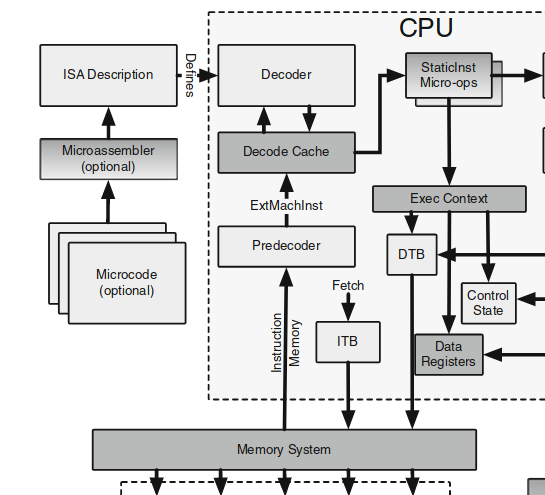decoder & decode cache 解析
先给出这部分的架构图:  这张图很清楚的解释了 cpu 译码部分的架构,由 decoder 从内存中获取指令数据,并把指令数据保存在自己的缓冲区中,decoder cache会在必要的时候调用 decoder 的 decode 方法,通过 decoder 进行译码,然后将译码的结果存储在 decoder cache中。cpu 获取的志指令应该是从 decoder cache 中获取的。下详细解释这些组件。
这张图很清楚的解释了 cpu 译码部分的架构,由 decoder 从内存中获取指令数据,并把指令数据保存在自己的缓冲区中,decoder cache会在必要的时候调用 decoder 的 decode 方法,通过 decoder 进行译码,然后将译码的结果存储在 decoder cache中。cpu 获取的志指令应该是从 decoder cache 中获取的。下详细解释这些组件。
decoder
decode 定义在 src/arch/generic/decoder.hh 中,这是一个抽象类,提供了译码的接口,将由各个体系结构吧自己去实现这个接口。这里主要有几个比较重要的接口:
instReady:表示当前 decoder 是否准备就绪,即是不是已经取到足够多的数据放在缓存中。needMoreBytes:返回一个 bool 值,表示当前解码器需不需要获取到新的数据填充到自己的缓冲区。moreBytes:从内存中读取足够多的指令到自己的缓冲区中。decode:核心的解码方法,由各个 ISA 提供者来具体实现,解码后返回StaticInstPtr,即一个独立于 ISA 的指令形式。
decoder cache
gem5 先在 src/cpu/decode_cache.hh 下实现了 AddrMap 作为 decoder cache 的基本组件,后在 src/arch/generic/decoder.hh 真正的实现 decoder cache 模板。
src/cpu/decode_cache.hh
/// Hash for decoded instructions.
template <typename EMI>
using InstMap = std::unordered_map<EMI, StaticInstPtr>;
/// A sparse map from an Addr to a Value, stored in page chunks.
template<class Value, Addr CacheChunkShift = 12>
class AddrMap
{
protected:
static constexpr Addr CacheChunkBytes = 1ULL << CacheChunkShift;
static constexpr Addr
chunkOffset(Addr addr)
{
return addr & (CacheChunkBytes - 1);
}
static constexpr Addr
chunkStart(Addr addr)
{
return addr & ~(CacheChunkBytes - 1);
}
// A chunk of cache entries.
struct CacheChunk
{
Value items[CacheChunkBytes];
};
// A map of cache chunks which allows a sparse mapping.
typedef typename std::unordered_map<Addr, CacheChunk *> ChunkMap;
typedef typename ChunkMap::iterator ChunkIt;
// Mini cache of recent lookups.
ChunkIt recent[2];
ChunkMap chunkMap;
/// Update the mini cache of recent lookups.
/// @param recentest The most recent result;
void
update(ChunkIt recentest)
{
recent[1] = recent[0];
recent[0] = recentest;
}
/// Attempt to find the CacheChunk which goes with a particular
/// address. First check the small cache of recent results, then
/// actually look in the hash map.
/// @param addr The address to look up.
CacheChunk *
getChunk(Addr addr)
{
Addr chunk_addr = chunkStart(addr);
// Check against recent lookups.
if (recent[0] != chunkMap.end()) {
if (recent[0]->first == chunk_addr)
return recent[0]->second;
if (recent[1] != chunkMap.end() &&
recent[1]->first == chunk_addr) {
update(recent[1]);
// recent[1] has just become recent[0].
return recent[0]->second;
}
}
// Actually look in the hash_map.
ChunkIt it = chunkMap.find(chunk_addr);
if (it != chunkMap.end()) {
update(it);
return it->second;
}
// Didn't find an existing chunk, so add a new one.
CacheChunk *newChunk = new CacheChunk;
typename ChunkMap::value_type to_insert(chunk_addr, newChunk);
update(chunkMap.insert(to_insert).first);
return newChunk;
}
public:
/// Constructor
AddrMap()
{
recent[0] = recent[1] = chunkMap.end();
}
Value &
lookup(Addr addr)
{
CacheChunk *chunk = getChunk(addr);
return chunk->items[chunkOffset(addr)];
}
};这个文件中首先声明了一个 InstMap 类型,这是一个从具体的机器指令到 gem5 中指令的 map,后续会有所使用。
对于 AddrMap 类,首先给出三个静态变量。随后定义 CacheChunk 即一个缓存块,一个缓存块可以包含多个 Value 数值。定义 recent 迭代器缓存用于加快查找,chunkMap 用来定义全局的 chunk 存储。update 方法用来更新迭代器缓存。getChunk 对于给定的地址返回缓存块。lookup 对于给定的地址返回其中缓存块的条目。
src/arch/generic/decoder.hh
template <typename Decoder, typename EMI>
class BasicDecodeCache
{
private:
decode_cache::InstMap<EMI> instMap;
struct AddrMapEntry
{
StaticInstPtr inst;
EMI machInst;
};
decode_cache::AddrMap<AddrMapEntry> decodePages;
public:
/// Decode a machine instruction.
/// @param mach_inst The binary instruction to decode.
/// @retval A pointer to the corresponding StaticInst object.
StaticInstPtr
decode(Decoder *const decoder, EMI mach_inst, Addr addr)
{
auto &entry = decodePages.lookup(addr);
if (entry.inst && (entry.machInst == mach_inst))
return entry.inst;
entry.machInst = mach_inst;
auto iter = instMap.find(mach_inst);
if (iter != instMap.end()) {
entry.inst = iter->second;
return entry.inst;
}
entry.inst = decoder->decodeInst(mach_inst);
instMap[mach_inst] = entry.inst;
return entry.inst;
}
};可以看到这个基本的缓存块实现中使用了 instMap 来加速译码过程,同时刚刚存储在缓存块中的 Value 类型为 AddrMapEntry。decode 实现核心的译码过程,并将 StaticInstPtr 返回给 cpu。这个方法的核心就是调用译码器进行译码,并更新相关的数值。